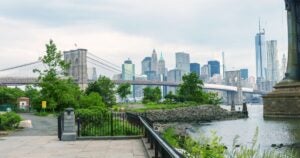
Cut carbon, raise cash: How New York’s cap-and-invest program could invest billions in communities
In leading climate states, you’ll find trailblazing projects that are benefiting people’s lives and cutting costly pollution right now.
In Washington, young people ride the ferry across Puget sound and buses around the state for free. In California, low-income residents get money-saving home energy efficiency upgrades at no cost. And in New York, businesses and apartments earn major rebates to install EV charging stations — with 4,000 stations installed so far.
These are just a few projects supported by funding from cap-and-invest programs. While limiting and driving down harmful climate pollution, these programs are in turn raising revenue that is re-invested in communities.
As New York develops the rules for its statewide cap-and-invest program — the third such program in the nation — a high-ambition program would give New Yorkers an exciting opportunity to shape and direct billions of potential investments each year for communities. From improving public transportation access to lowering energy bills, the possibilities are endless.
Here are just a few ways that other statewide programs, like California and Washington, are putting their revenues to work, and how New York’s participation in the Regional Greenhouse Gas Initiative (RGGI) is already funding projects around the state — investments that could be significantly expanded and scaled up with a strong statewide cap-and-invest program.
First, let’s talk about the “invest” in cap-and-invest
Cap-and-invest programs, like the one being developed by Governor Hochul and state agency officials, are designed to cut carbon and raise cash. The pollution “cap,” also called a limit, determines the maximum allowable amount of climate pollution that can be emitted across the state each year, and it gets tighter over time to align with New York’s climate goals. Major polluters regulated under the program have to hold “allowances” to cover each ton of their emissions. The state auctions or distributes only as many allowances as add up to the total cap.
The market for allowances puts a cost on pollution, meaning polluters are highly incentivized to emit less of it. As the pollution cap declines, allowances become more scarce and more expensive. Over time, the choice becomes clearer and clearer: deploying clean energy and other sustainability strategies to cut pollution makes the most business sense.
In the meantime, the state raises cash from the sale of those emissions allowances that can be invested into a variety of projects that benefit New York communities — accelerating the transition to clean energy, reducing air pollution, protecting communities from natural disasters, ensuring affordable energy, and much more.
Washington’s cap-and-invest
While Washington’s cap-and-invest program just completed its first year of operation, it has already raised over $1.8 billion in revenue that will be invested into communities across the state to build climate resilience, improve air quality, create jobs, and more. As in New York, at least 35% of these investments must benefit communities that are overburdened by air pollution and most vulnerable to climate impacts. Here are just a few ways Washington residents will benefit from these investments, which are beginning to roll out across the state:
- More access to cleaner public transit including free ferry, bus, and other transit rides for youth.
- Cleaner air for children in and around schools with upgrades to zero-emissions school buses and new, efficient HVAC systems.
- Lower energy bills for low-income households and small businesses who receive support for replacing old gas furnaces with modern and efficient electric alternatives.
California’s cap-and-trade
For over a decade, California’s cap-and-trade program has been driving down pollution while raising over $26 billion in proceeds for projects to support clean, healthy and resilient communities. Agencies report directing about 75% of the program’s investments in low-income communities and communities overburdened by pollution. Here’s a small sample of the many ways California residents are seeing the benefits of these investments:
- Neighborhood-level transformation underway in 37 communities facing the highest levels of poverty, pollution and underinvestment through community-led visioning and integrated climate investments. Impacts range from greater housing and transit access, to safer spaces to walk and bike, to urban green spaces, community microgrids, and more.
- Cleaner, safer, cheaper public and active transit options with more than 1,000 projects funded in communities across the state ranging from electric bike hubs in affordable housing communities to on-demand clean community shuttles for seniors, expanded bike lanes, resident-driven transportation planning, and much more.
- Over 400,000 rebates issued to help residents upgrade to clean and efficient zero-emissions and plug-in hybrid vehicles, freeing them from volatile prices at the pump. And, dedicated investments in community-based organizations have helped connect underserved communities with these game-changing clean vehicle incentives.
New York’s participation in RGGI
New York has been part of a regional cap-and-invest program cutting pollution from power plants in the northeast since 2009. While helping to cut power plant pollution in half across participating states, the program has generated over $2 billion in revenue in New York state alone. Funding over 50 programs, these investments are accelerating clean energy, energy efficiency, workforce development, and more. Here are just a few of the benefits New Yorkers have seen supported by this funding — benefits that could be scaled, expanded, and built upon with a statewide cap-and-invest program in place:
- Hyper-local air monitoring pilots underway in 10 disadvantaged communities with high air pollution burdens across the state. Monitoring will inform community-specific strategies to cut harmful pollution.
- Connecting individuals with good-paying clean energy jobs through workforce development and training opportunities. One of many funded programs has resulted in 1,300 workers hired by over 150 clean energy businesses following on-the-job training opportunities. These growing programs are prioritizing minority- and women-owned businesses, training and job opportunities for disadvantaged community residents, and union-led apprenticeship and training programs.
- Over 4,000 electric vehicle charging ports installed at workplaces, multi-unit housing, and public facilities around the state, thanks to RGGI-funded rebates.
Around the country, cap-and-invest programs are cutting costly pollution and delivering benefits to communities. A statewide cap-and-invest program in New York would greatly expand the job, health and cost-savings benefits New Yorkers have seen for the past 15 years via RGGI. Investments can and should be tailored to communities needs and reach more families, businesses, and organizations around the state. New Yorkers will have opportunities ahead to shape how the cap-and-invest program works and ensure funding is invested where it is most needed.
Most immediately, New Yorkers have an opportunity to weigh in on the ongoing process to design the cap-and-invest program, led by New York’s Department of Environmental Conservation and the New York State Energy Research and Development Authority. It’s a great time to make your voice heard on why a strong cap-and-invest program matters for cutting pollution and driving investments to make your community safer, healthier, and more affordable today and for future generations.















